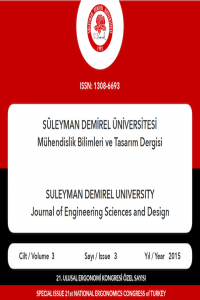Year 2015,
Volume: 3 Issue: 3, 391 - 399, 25.12.2015
Abstract
Bu çalışma Toros Üniversitesi’nde 2014-2015 yaz döneminde eğitim gören kolayda örnekleme ile seçilen 65 öğrenci ile yürütülmüş olup eğitim ortamında pencere, kapı, sınıf ve saatin çevresel faktörlerin (CO2 yoğunluğu, sıcaklık, bağıl nem, ve ses şiddeti) öğrencilerin eğitime etkisini araştırmaktadır. Elde edilen bulgular, küçük sınıflarda kapı ve pencereler kapalı iken ve öğle saatlerinde gerçekleştirilen eğitimlerin daha uygun olduğunu göstermektedir.
References
- Boyacıoğlu, H., Güneri, P. (2006). Sağlık Araştırmalarında Kullanılan Temel İstatistik Yönetemler, Hacettepe Dişhekimliği Fakülte Dergisi, 30(3):33-39.
- Fraga S., Ramos E., Martins A., Samúdio M.J., Silva G., Guedes J., Fernandes E.O., Barros H. (2008). Indoor air quality and respiratory symptoms in Porto schools. Rev. Port. Pneumo.2008;14:487–507
- Huang L., Zhu Y., Quayang Q., Cao B. (2011). A study on the effects of thermal, Luminous and acoustic environmentals on indoor environmental comfort in offices. Building and Environment,304-309.
- Karabiber, K., Vallet M. (2003). Classroom acoustics policies. Italy.
- Karasar, N. (1999). Bilimsel Araştırma Yöntemleri, Nobel Yayıncılık, 9. Basım, Ankara, ss.53-70.
- Krüger, E. L., Zannih P.H.T. (2004). Acoustic, thermal and luminous comfort in classrooms. Building and Environment, 1055-1063.
- Myhrvold A.N., Olsen E., Lauridsen O. (1996). Indoor Environment in Schools-Pupils Health and Performance in regard to CO2Concentrations; Proceedings of Indoor Air ’96: The 7th International Conference on Indoor Air Quality and Climate; Nagoya, Japan. 21–26 July 1996; pp. 369– 374.
- Nkwocha E.E., Egejury R.O. (2008). Effects of industrial air pollution on the respiratory health of children. Int. J. Environ. Sci. Tech.2008;5:509–516. doi: 10.1007/BF03326048.
- Rittner, H. (2002). Color and light in learning. School Planning & Management, 57-58.
- Sheehy J.B., Kamon E., Kiser D. (1982). Effects of carbon dioxide inhalation on psychomotor and mental performance during exercise and recovery. Hum Factors. 24(5):581-8.
- Satish U., Mendell M.J., Shekhar K., Hotchi T., Sullivan D., Streufert S., Fisk W.J. (2012). Is CO2 an indoor pollutant? Direct effects of low-to-moderate CO2 concentrations on human decision-making performance. Environ. Health Perspect. 2012;120:1671–1677.
- The National Health Surveillance Agency (ANVISA) Resolution RE n. 9. Jan 16, 2003.
- Vercruyssen M., Kamon E., Hancock P.(2007). Effects of carbon dioxide inhalation on psychomotor and mental performance during exercise and recovery. Int. J. Occup. Saf. Ergon. 2007;13:15–27.
- Zannin, P. H.T. (2004). Acoustic of classrooms in Brazilian Public Schools - A case study in Curitiba. Congr[es Fran:cais d’Acoustique CFA, 30th Deutsche Jahrestagung feir Akustik DAGA.
Year 2015,
Volume: 3 Issue: 3, 391 - 399, 25.12.2015
Abstract
References
- Boyacıoğlu, H., Güneri, P. (2006). Sağlık Araştırmalarında Kullanılan Temel İstatistik Yönetemler, Hacettepe Dişhekimliği Fakülte Dergisi, 30(3):33-39.
- Fraga S., Ramos E., Martins A., Samúdio M.J., Silva G., Guedes J., Fernandes E.O., Barros H. (2008). Indoor air quality and respiratory symptoms in Porto schools. Rev. Port. Pneumo.2008;14:487–507
- Huang L., Zhu Y., Quayang Q., Cao B. (2011). A study on the effects of thermal, Luminous and acoustic environmentals on indoor environmental comfort in offices. Building and Environment,304-309.
- Karabiber, K., Vallet M. (2003). Classroom acoustics policies. Italy.
- Karasar, N. (1999). Bilimsel Araştırma Yöntemleri, Nobel Yayıncılık, 9. Basım, Ankara, ss.53-70.
- Krüger, E. L., Zannih P.H.T. (2004). Acoustic, thermal and luminous comfort in classrooms. Building and Environment, 1055-1063.
- Myhrvold A.N., Olsen E., Lauridsen O. (1996). Indoor Environment in Schools-Pupils Health and Performance in regard to CO2Concentrations; Proceedings of Indoor Air ’96: The 7th International Conference on Indoor Air Quality and Climate; Nagoya, Japan. 21–26 July 1996; pp. 369– 374.
- Nkwocha E.E., Egejury R.O. (2008). Effects of industrial air pollution on the respiratory health of children. Int. J. Environ. Sci. Tech.2008;5:509–516. doi: 10.1007/BF03326048.
- Rittner, H. (2002). Color and light in learning. School Planning & Management, 57-58.
- Sheehy J.B., Kamon E., Kiser D. (1982). Effects of carbon dioxide inhalation on psychomotor and mental performance during exercise and recovery. Hum Factors. 24(5):581-8.
- Satish U., Mendell M.J., Shekhar K., Hotchi T., Sullivan D., Streufert S., Fisk W.J. (2012). Is CO2 an indoor pollutant? Direct effects of low-to-moderate CO2 concentrations on human decision-making performance. Environ. Health Perspect. 2012;120:1671–1677.
- The National Health Surveillance Agency (ANVISA) Resolution RE n. 9. Jan 16, 2003.
- Vercruyssen M., Kamon E., Hancock P.(2007). Effects of carbon dioxide inhalation on psychomotor and mental performance during exercise and recovery. Int. J. Occup. Saf. Ergon. 2007;13:15–27.
- Zannin, P. H.T. (2004). Acoustic of classrooms in Brazilian Public Schools - A case study in Curitiba. Congr[es Fran:cais d’Acoustique CFA, 30th Deutsche Jahrestagung feir Akustik DAGA.
There are 14 citations in total.
Details
| Primary Language | Turkish |
|---|---|
| Journal Section | SI:ERGONOMI2105 |
| Authors | |
| Publication Date | December 25, 2015 |
| Submission Date | October 23, 2015 |
| Published in Issue | Year 2015 Volume: 3 Issue: 3 |

